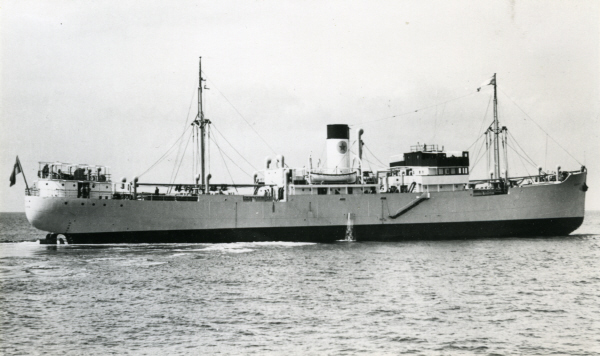Sicilia
Swedish Motor merchant

Photo courtesy of Sjöhistoriska Museet, Stockholm
| Name | Sicilia | ||
| Type: | Motor merchant | ||
| Tonnage | 1,633 tons | ||
| Completed | 1934 - Kockums Mekaniska Verksteds A/B, Malmö | ||
| Owner | Rederi-A/B Svenska Lloyd, Gothenburg | ||
| Homeport | Gothenburg | ||
| Date of attack | 27 May 1943 | Nationality: | |
| Fate | Sunk by U-181 (Wolfgang Lüth) | ||
| Position | 24° 31'S, 35° 17'E - Grid KP 3578 | ||
| Complement | 23 (0 dead and 23 survivors). | ||
| Convoy | |||
| Route | Buenos Aires (3 May) - Lourenço Marques (26 May) - Beira | ||
| Cargo | 6241 bags of wheat flour and 327 tons of Eno’s Fruit Salt in 300 boxes | ||
| History | Completed in August 1934 Sicilia rescued 33 survivors from the Trepca which had been sunk by U-332 (Liebe) on 13 March 1942. Shortly afterwards she loaded flour and medical supplies from the American Greek War Relief for the civilian population of Greece and left New York on 26 March 1942, routed via Gibraltar and given safe conduct by all nations as Red Cross ship. | ||
| Notes on event | At 06.11 hours on 27 May 1943 the unescorted and unarmed Sicilia (Master Carl I. Janson) was stopped by U-181 with ten rounds from the deck gun fired across her bow while steaming on a non-evasive course at 12.5 knots about 5 miles east of Ponta Zavora Lighthouse. The U-boat had spotted the illuminated ship about 12 hours earlier shortly after she had left Lourenço Marques and followed her along the coast until attacking at dawn from her starboard quarter. The whole crew quickly abandoned ship in two lifeboats because two of the warning shots fell only a few feet from the stern and bow of the vessel. They were approached by U-181 which took the master and the chief officer aboard for questioning and examination of the papers. The Sicilia was not on the list of neutral ships with free conduct, but her master explained that his ship was employed as feeder and supposed to load copra at Beira, Macuze and Quelimane to be transferred in Buenos Aires to a ship bound for Sweden. Lüth initially believed him and after one hour intended to ask the BdU for orders by radio, expecting an answer until 18.00 hours, so he advised the master to proceed at 5 knots towards Beira while being followed by the U-boat and warned him not to attempt escape or signal. However, when the Swedish officers were about to get back into the lifeboats it occurred to Lüth that the ship’s papers weren’t complete and asked to see their logbook. They answered that it had been left behind, so a lifeboat rowed back to the ship and the second officer retrieved it from the bridge. However, it was new and only begun a few days ago, so the chief officer was sent to fetch the old one and returned at 08.00 hours. Evidently the Sicilia had been trading between North and South America the year before, therefore Lüth now strongly doubted the neutral nature of the voyage and eventually gave the Swedish crew 30 minutes to retrieve their personal belongings and more provisions before sinking their ship. Her master told him that he had already lost his last ship under similar circumstances in December 1942 (when Scania was sunk by U-176) and protested against the sinking, stating that it was a neutral vessel with a neutral cargo. Lüth told him: I’m very sorry, but war is war. In fact, the voyage had been arranged by a British agency and a part of the cargo of flour unloaded at Lourenço Marques was shipped by rail to South Africa. It took the lifeboats 15 minutes to reach the drifting ship, so the Swedes hurried to get together what they could and left again. At 08.29 hours U-181 fired a coup de grâce that struck the Sicilia on starboard side amidships and caused her to sink by the bow with a list to starboard within two minutes in position 24°29N/35°20E. Afterwards the U-boat approached the lifeboats and subsequently left the area after the survivors negated when Lüth asked them if they wanted anything, offering bread and cigarettes. Shortly thereafter a Portuguese aircraft approached from land and circled the lifeboats and wreckage several times, signaling the survivors that it will return and then headed inshore again. As wind and sea were increasing the boats decided to head north and sailed along the shore. At 16.30 hours they made landfall in a bay north of Cape Corrientes, where the harbor master from Inhambane was already waiting for them, helped to get the boats on the beach and gave them a hut to sleep for the night. The next day the survivors were transported to Inhambane in two trucks and on 29 May in a bus to Lourenço Marques. They later returned from Durban to Buenos Aires aboard the Argentine steam passenger ship José Menendez. | ||
| On board | We have details of 2 people who were on board. | ||
If you can help us with any additional information on this vessel then please contact us.
